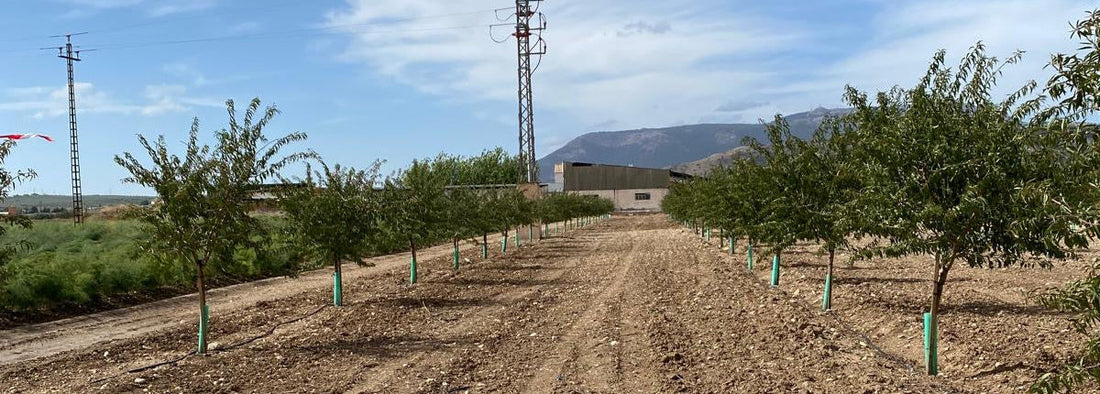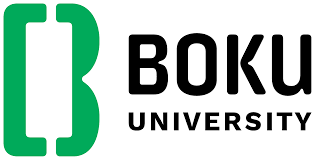
Use of RETENTIS® in New Almond Plantings
Share
Executive Summary
RETENTIS® (biological water-retaining granulate) stabilizes young almond plants under −30 % irrigation while simultaneously improving vitality parameters. The key figures below summarize the strongest effects (each vs. control 70 %), illustrating the consistent chain SPAD ↑ → NDVI ↑ → VIGOR ↑ → Yield ↑.
*Calculation basis: 285 trees/ha; 1 bathtub ≈ 150 l.
Spain experienced the worst drought in three decades. In Catalonia, reservoirs fell below 16% capacity at the beginning of 2024; the regional government reduced irrigation by 20% [1]. In Andalusia as well, the state is investing over €280 million in emergency infrastructure [2]. Stable water management is becoming a matter of survival for almond producers.
1. Initial Situation
Around 800,000 ha of almonds; up to 10,000 m³/ha per season; 1 kg of almonds sometimes requires ≈ 4,000 l of water.
In Spain, around 800,000 hectares of almonds are currently cultivated. The crop is predominantly grown in very dry regions, which makes artificial irrigation indispensable. However, the intensity of irrigation varies greatly: about 150,000 to 200,000 hectares are considered intensively irrigated. With water consumption of up to 10,000 m³ per hectare and season, almonds are among the most water-intensive specialty crops. Estimates suggest that producing just 1 kilogram of almonds can require up to 4,000 liters of water — a significant environmental footprint, especially in times of increasing water scarcity. Against this backdrop, the present two-year field trial (2023–2024) investigated the use of the biological water-retaining granulate Retentis® in almond cultivation. The granulate was incorporated directly into the soil at planting. The aim was to evaluate the impact of different Retentis® application rates and two irrigation strategies — full irrigation (100%) and reduced irrigation (−30%) — on early-stage development, vitality over time, and yield in the second year after planting.
2. Trial Design
- Location: Valderrubio (Granada), Andalusia
- Variety: Lauranne
- Planting date: 25/01/2023
- Spacing: 7 m × 5 m; Density: ≈ 285 trees/ha
- Design: 6 variants, 5 trees each
- Application: RETENTIS® in the planting hole, mixed with backfill into the root zone to approx. 20 cm
3. Variants
Full irrigation (reference for “% vs 100%”).
−30% irrigation (reference for “% vs 70%”).
70% irrigation, entry dose.
70% irrigation, practical rate.
70% irrigation, higher reserve.
70% irrigation, maximum tested dose.
4. Irrigation
Drip irrigation. Per cycle: 40 l/tree (100%) vs 28 l/tree (70%); 30× per season.
5. Results
5.1 Vigor (VIGOR) – 2023 & 2024
The combination of better water retention, steady nutrient supply, and reduced stress results in visibly more vigorous trees. This effect already appears in the first growing season and remains stable over a two-year period.
Key takeaway: Under 70% irrigation, 100–200 g RETENTIS® achieves vigor on par with the 100% control; 50 g has a smaller effect.


5.2 Yield – Year 2 (2024)
In the second year of the trial, yield from the young plantings at the same site was evaluated for the first time. Clear positive effects were observed from the use of RETENTIS®. All variants with RETENTIS® were managed under reduced irrigation (−30%). Compared to the fully irrigated control (100%), yield increases of +4.7% to +7.6% were achieved. Compared to the control with 70% irrigation, yield gains were even between +8.8% and +11.7%.
5.3 SPAD (Chlorophyll) – 2023 & 2024
The hydrogel contributes to more uniform nutrient uptake. By improving moisture distribution and nutrient retention capacity, nitrogen and other nutrients are absorbed more efficiently, increasing chlorophyll content and thus photosynthetic performance. SPAD consistently rises with the RETENTIS® dose (100–200 g). This aligns with higher NDVI and explains vigor/yield advantages.
5.4 Flowering – March 2024
The assessment of flowering was carried out on March 8th, 2024 (full bloom). A slight but consistent increase in the percentage of flowering was observed in all RETENTIS® treatments. The effect was more pronounced compared to the untreated control with reduced irrigation (70%) than to the fully irrigated control (100%). The highest flowering intensity was recorded at 150–200 g RETENTIS® per plant.
5.5 NDVI (Vitality) – 2023 & 2024
NDVI increases in both years (100–200 g) — consistent with SPAD and explaining the rise in vigor. The hydrogel improves water availability in the root zone and stabilizes leaf activity under reduced irrigation. Plants can sustain photosynthesis and growth even with 30% less water input.
6. Conclusion
For new almond plantings under semi-arid conditions, the use of 100–200 g AGROBIOGEL per plant is recommended to save water while increasing vitality and yield potential.
- −30% irrigation is feasible with RETENTIS® without losses in growth & yield.
- Recommendation: 100–200 g/tree in the planting hole (≈ 20 cm root zone).
- Chain: SPAD ↑ · NDVI ↑ · VIGOR ↑ → Yield ↑.
7. ROI – Profitability
Over the first 3–5 years (the minimum effective duration of Retentis in the soil), the following positive ROI results for the producer (return-on-investment calculation):
*Calculation basis: 285 trees/ha; 1 bathtub ≈ 150 l.
8. Appendix – Methodology & Interpretation
To assess the effect of RETENTIS®, three complementary vitality parameters were used: VIGOR, SPAD, and NDVI. They capture different physiological aspects of plant status and together enable a holistic assessment of development, nutrient supply, and stress resilience of young plants under varying irrigation conditions.
VIGOR (growth/vigor)
Visual composite index in the range 0–100, based on shoot growth, leaf mass, and general plant condition. Measurements were taken by trained scorers according to a standardized protocol. Meaning: Degree of establishment, vitality, and drought-stress tolerance. Interpretation: Increases markedly in RETENTIS® variants despite −30% irrigation — an indication of better establishment and higher stress resilience.
SPAD (chlorophyll index)
Optical leaf measurement with a SPAD meter using two wavelengths (red and near-infrared). It provides a relative index of chlorophyll content and thus an indirect indication of the plant’s nitrogen status. Meaning: Nutritional and photosynthetic status. Interpretation: Higher SPAD values at application rates of 100–200 g RETENTIS® indicate more efficient nutrient uptake and improved leaf health.
NDVI (Normalized Difference Vegetation Index)
Calculated from reflectance in the near-infrared (NIR) and red spectral bands using the formula (NIR−R)/(NIR+R). Values typically range between 0.2 (low activity) and 0.9 (high activity). Meaning: Proportion of active leaf area, leaf greenness intensity, and photosynthetic performance. Interpretation: In RETENTIS® variants, NDVI rises as early as spring (April) and remains at a high level throughout the growing season — explaining the higher vitality and yield.
Overall linkage: Increased soil water-holding capacity through RETENTIS® → improved nutrient availability → higher SPAD values → increased NDVI activity → stronger VIGOR expression → higher yields.
9. References
- The Guardian (01/02/2024): Catalonia declares drought emergency, extending restrictions to Barcelona.
- Sur in English (07/05/2024): Granada prepares for drought crisis with 280 m euro investment.








